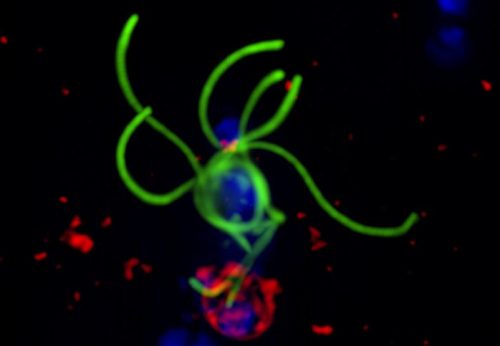Scientists have identified compounds that could prevent malaria parasites from infecting mosquitoes. This would subsequently halt the spread of the disease, say researchers from Imperial College London.
Preventing disease transmission from malaria parasites is a key part in the battle against the spread of the disease.
We can cure humans of the disease using drugs that eliminate the replicating form of the parasite. However, they continue carrying the dormant, sexual forms. When a mosquito bites a human, these are responsible for transferring the parasite to the insect.
When they are inside the mosquito, the dormant parasites mature rapidly. They subsequently multiply, leaving them ready to infect a new human when the mosquito feeds again.
Compounds affect malaria parasites
Imperial College London is leading a team of scientists who have identified several compounds. These compounds can prevent malaria parasites from maturing when they are inside the mosquito.
Professor Jake Baum and colleagues wrote about their study and findings in the prestigious journal Nature Communications (citation below). Lead author, Prof. Baum, works at the Department of Life Sciences at Imperial College London (Imperial).

Prof. Baum said:
“Current antimalarial drugs can cure a person of the disease, but that person is still infectious to mosquitoes, and can therefore still cause someone else to become infected.”
“What we propose is antimalarial drugs that protect mosquitoes, blocking the parasites from continuing their infectious journey. By combining such a drug with a conventional antimalarial, we not only cure the individual person, but protect the community as well.”
“At the level of the individual person, fighting malaria is a constant battle as parasites become resistant to antimalarial drugs. Since transmission occurs in the mosquito, drugs targeting this process have the added benefit of being naturally much more resistance-proof, which could be essential for eliminating malaria.”
Complex lifecycle of malaria parasites
One animal study has already shown that a compound can block parasite transmission from mice. However, the scientists are researching all the compounds further. They want to find out exactly how each one works on malaria parasites.
They also want to determine how to adapt these compounds as future drugs.
We can’t, for example, give these drugs directly to mosquitoes. Therefore, they would need to be stable enough to be administered to a human. Then, they would need to continue being effective until a mosquito feeds on that person.
Finding out what each compound does could also tell us more about the biology of the transmission process. We could then identify new targets for future drugs.
Malaria parasites have very complex lifecycles. When humans become infected, they have asexual forms of the parasite in their bloodstream. These cause the symptoms of malaria.
However, there are also male and female sexual forms present. Once they mature, they remain dormant in the human body.
These malaria parasites are difficult to attack with conventional drugs because they are dormant and not very reactive.
However, it is precisely these male and female forms that, after sex, create newly infectious asexual malaria parasites. These gather in the salivary glands of the mosquito, ready to pass on malaria to the next unfortunate person the mosquito bites.
Screening 14,000 compounds a week
The sexual malaria parasites are very active while inside the mosquito. They are one of the fastest replicating cell types we know about. This, surprisingly, makes them exceptionally-good drug targets.
The scientists mimicked the conditions inside mosquitoes in their quest for compounds. Specifically, compounds that could disrupt the sexual malaria parasites. In other words, they fooled the parasites into beginning sexual development.
As soon as they found the ideal conditions, they miniaturized the process. They could then examine the process with a microscope.
This allowed the researchers to screen thousands of compounds to determine whether they affected the active sexual parasites.
As Prof. Baum explained, it took a long time to find the ideal conditions:
“It took several years to find the right conditions that would stimulate the sexual parasites and to miniaturize the environment, but it was worth it – at our best we were screening 14,000 compounds a week!”
“Overall we screened around 70,000 molecules and found only a handful of potent compounds that are both active and safe to use with human cells. It was like finding needles in a haystack.”
Citation
“A high throughput screen for next-generation leads targeting malaria parasite transmission,” Michael J. Delves, Celia Miguel-Blanco, Holly Matthews, Francisco J. Gamo, Irene Molina, Andrea Ruecker, Sabrina Yahiya, Ursula Straschil, Esperanza Herreros, Matthew Abraham, María Luisa León, Oliver J. Fischer, Robert E. Sinden, Ainoa Rueda-Zubiaurre, Jochen R. Brandt, Álvaro Cortés, Elizabeth A. Winzeler, Anna Barnard, Matthew J. Fuchter, Félix Calderón, and Jake Baum. Nature Communications 9, Article number: 3805 (2018). DOI: https://doi.org/10.1038/s41467-018-05777-2, ISSN 2041-1723 (online).

